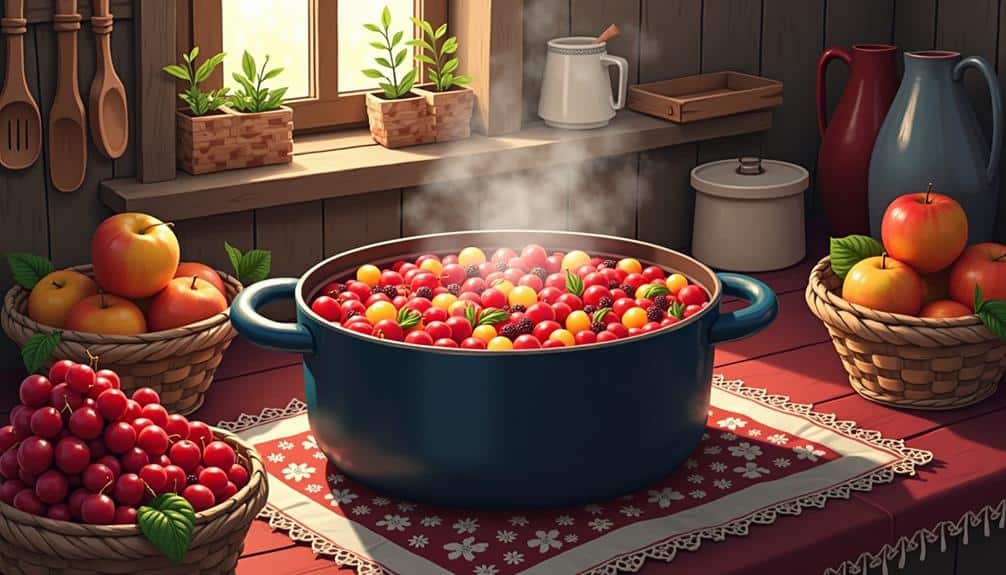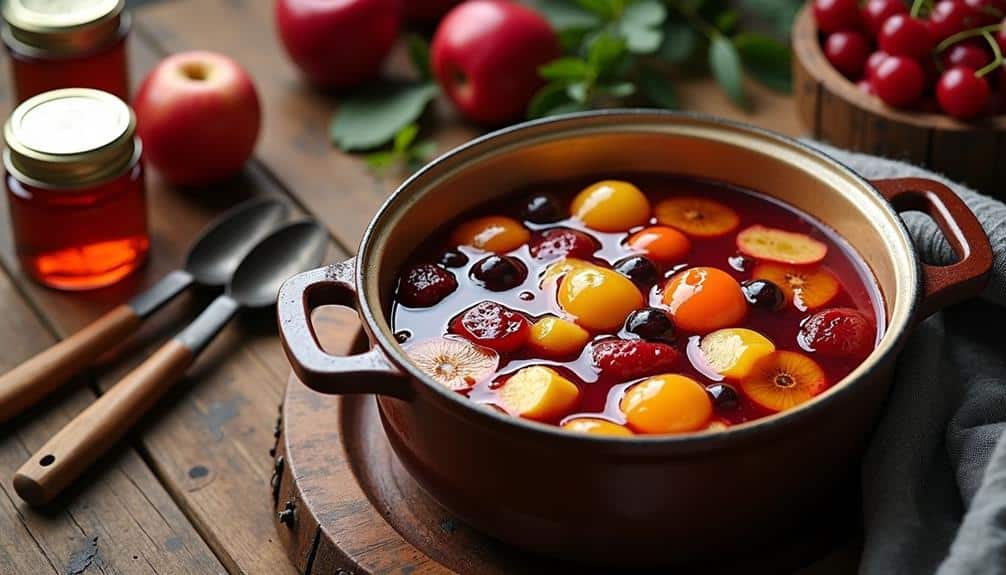Imagine you’re at a Russian family gathering, and someone offers you a glass of kompot, a traditional beverage that has been cherished for centuries. This drink isn’t just invigoratingly sweet; it carries a deep cultural significance rooted in the agrarian traditions of Eastern Europe. As you take a sip, you’re tasting a piece of history that symbolizes resourcefulness and community spirit. Curious about how this simple mixture of water and fruits evolved into a cultural staple? Understanding its origins and the way it connects generations might just reveal why this drink holds a special place in Russian hearts.
Origins of Kompot

In the heart of Eastern Europe, Kompot has a storied origin that reflects the cultural and agricultural richness of Russia. This traditional beverage, made from a medley of fruits, has deep historical significance dating back centuries. You can trace its roots to an era when the agrarian lifestyle dominated Russian society. People relied heavily on seasonal harvests, and Kompot emerged as a creative way to utilize surplus fruits.
Understanding Kompot’s origins requires appreciating the cultural rituals that have shaped it. Russian families traditionally prepared Kompot during summer and autumn, preserving the bountiful harvests for the colder months. This practice wasn’t just about sustenance; it was also a communal activity that brought families together. Women and children would gather to wash, prepare, and cook the fruits, turning the process into a cherished cultural ritual.
Kompot’s historical significance goes beyond mere nutrition. It symbolizes resourcefulness and community spirit, key aspects of Russian culture. The drink has been a staple at festive gatherings, from village feasts to grand celebrations, further embedding it into the fabric of Russian life.
Medieval Preservation Methods
Delving into medieval preservation methods for Kompot, you’ll uncover a fascinating blend of practicality and ingenuity. In an era without refrigeration, Eastern European communities had to rely on natural fermentation techniques and clever medieval storage solutions to enjoy their beloved drink year-round.
Fermentation wasn’t just a method; it was a necessity. By allowing the natural sugars in the fruit to ferment, they created a mildly alcoholic beverage that could be stored for extended periods without spoiling.
Medieval storage practices were equally inventive. Large clay jars and wooden barrels, often sealed with wax or pitch, were used to store Kompot in cool, dark cellars or buried underground.
These environments maintained a consistent temperature, essential for preserving the drink’s freshness and nutritional value. This method also emphasized the importance of local resources—clay, wood, and beeswax—all readily available and sustainable.
Culturally, these preservation methods underscored a profound connection to the land and seasons. By mastering fermentation techniques and utilizing effective medieval storage, communities not only secured their food supply but also maintained a cherished tradition that embodied resilience and resourcefulness.
Such practices reflect a deep-rooted wisdom that continues to resonate in modern times.
Ingredients and Preparation

The essence of Kompot lies in its simple yet versatile ingredients, reflecting the resourcefulness and culinary traditions of Eastern European cultures.
To make this age-old beverage, you’ll need a selection of fresh or dried fruits. Popular options include apples, cherries, strawberries, and apricots. Feel free to experiment, as nearly any fruit works—berries bring a tart freshness, while stone fruits add a rich depth.
Begin by washing and chopping your chosen fruits. If you’re using dried fruits, soak them in warm water for about 30 minutes beforehand.
Place the fruit in a large pot, cover with water, and add sugar to taste. Typically, you’d use about 1 cup of sugar for every liter of water, but this can be adjusted based on your sweetness preference.
Bring the mixture to a boil, then reduce to a simmer for around 30-40 minutes. This slow cooking process extracts the natural flavors, creating a harmonious blend.
Once done, let it cool before straining.
Kompot can be enjoyed warm during colder months or chilled in summer, making its serving temperature quite adaptable. This flexibility underscores Kompot’s place as a comforting, year-round staple in Russian households.
Regional Variations
Exploring the regional variations of Kompot highlights the rich tapestry of local ingredients and traditions that shape this beloved beverage across Eastern Europe.
You’ll find that each area boasts its unique fruit combinations, reflecting the local flora and agricultural practices. In Russia’s Central region, apple and berry compotes are popular due to the abundance of these fruits.
Moving south to the Caucasus, you’ll notice an inclusion of stone fruits like apricots and peaches, lending a sweeter, richer flavor profile.
In Ukraine, dried fruits such as prunes and raisins are often used, especially in winter, to create a hearty, warming drink.
Meanwhile, in the Baltic states, you might find a tangier version made with rhubarb and red currants, which perfectly balances sweet and tart notes.
Serving traditions also vary. In some regions, Kompot is served chilled during the hot summer months as a revitalizing drink, while in others, it’s enjoyed warm, providing comfort during the colder seasons.
Whether served in a grand crystal decanter at festive gatherings or in simple glass jars for everyday meals, these regional differences in Kompot offer a glimpse into the diverse cultural landscapes of Eastern Europe.
Kompot in Russian Festivals

When you attend Russian festivals, you’ll quickly notice that Kompot is more than just a drink—it’s a symbol of hospitality and tradition. At these cultural celebrations, Kompot is often served in large, ornate bowls, highlighting its importance. Families and friends gather, sharing stories and laughter over this cherished beverage, which is made by simmering a variety of fruits in water and sugar.
Kompot festivals are particularly popular during the summer and harvest seasons when fruits like apples, berries, and cherries are plentiful. These festivals not only celebrate the drink itself but also the agricultural bounty from which it’s made. You’ll find stalls adorned with colorful jars of Kompot, each showcasing unique regional recipes.
In Russian cultural celebrations, offering Kompot to guests is a gesture of warmth and generosity. It’s common to see hosts pouring glasses of this invigorating beverage as a way to welcome attendees.
The presence of Kompot at these events underscores its role in the communal and familial bonds that are central to Russian society. As you sip your Kompot, you’re partaking in a tradition that connects generations and fosters a sense of unity.
Health Benefits
Beyond its cultural significance, Kompot offers a variety of health benefits that make it a beloved beverage for many Russian families. You’ll find that its nutritional value is one of the key reasons people continue to cherish this traditional drink.
Kompot is typically made from a mix of dried and fresh fruits like apples, plums, apricots, and berries, which are rich in essential vitamins and minerals. These fruits provide a natural source of antioxidants, which help combat oxidative stress and support overall health.
Moreover, Kompot has significant digestive benefits. The fruits used in its preparation are high in dietary fiber, which aids in maintaining a healthy digestive system. This fiber helps regulate bowel movements and can alleviate common digestive issues such as constipation.
The gentle simmering process used in making Kompot guarantees that the nutrients remain intact, making it a nourishing option for people of all ages.
Culturally, Kompot’s health benefits aren’t just incidental; they’re integral to why it’s served at family gatherings and festive occasions. When you drink Kompot, you’re not just enjoying a revitalizing beverage; you’re partaking in a tradition that values both taste and well-being.
Modern-Day Kompot

In today’s world, Kompot has evolved while retaining its cherished place in Russian culture. You’ll find that modern-day Kompot embraces both tradition and innovation. By incorporating flavored variations and seasonal fruits, families continue to celebrate its versatility and cultural significance.
Modern kitchens now see a creative twist in Kompot recipes. You can experiment with different combinations of seasonal fruits, such as strawberries in summer or apples in autumn, making it a drink that changes with the rhythms of nature. Some even add spices like cinnamon or mint to enhance the flavor profile, creating a unique experience each time.
Despite these innovations, the essence of Kompot remains unchanged. It still brings people together, evoking memories of simpler times and familial warmth. You might notice that during holidays and special occasions, Kompot is a staple on Russian tables, embodying a sense of continuity and heritage.
Moreover, the ease of preparation makes it accessible to everyone. Whether you’re a novice cook or an experienced chef, you can make Kompot a part of your culinary repertoire, thereby fostering a deeper connection to Russian culture and tradition.
Conclusion
You’ve explored the rich history and cultural significance of kompot, a drink that embodies Russian heritage. By appreciating its origins, medieval preservation methods, and diverse ingredients, you gain insight into regional variations and its role in festivals. Understanding kompot’s health benefits and modern adaptations connects you to a tradition that transcends time, fostering community and nostalgia. Embrace kompot not just as a beverage, but as a symbol of resourcefulness and hospitality in Russian culture.




